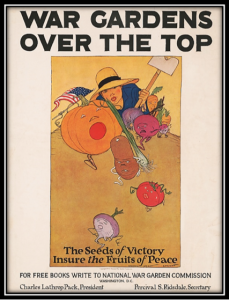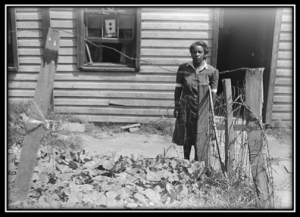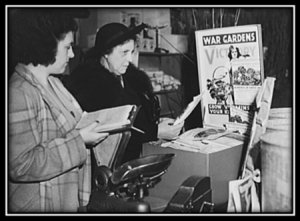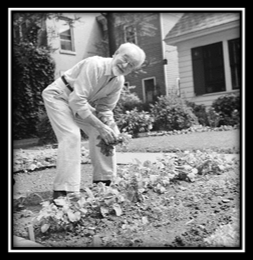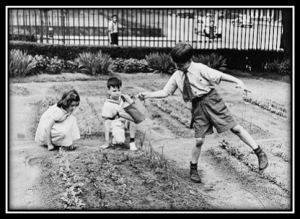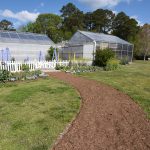Vital to Victory – Victory Gardens
What is a Victory Garden?
Utilized during World War I and World War II, Victory Gardens consisted of a variety of vegetable, fruit, and herb gardens planted at private residences, as well as at schools, parks, and other public spaces across the country to provide supplement food sources in wartime.
The Seeds of Victory Insure the Fruits of Peace
Introduced in the United States during World War I, the National War Garden Commission developed a “war garden” aid program that called on Americans to assist with large-scale food production to export to their war-torn allies in Europe. Propaganda posters and pamphlets were widely dispersed to encourage participation in these gardening programs, and even included information on canning and drying surplus produce to ensure nothing went to waste stateside and abroad. By the end of the war in 1918, the United States had shipped millions of tons of food to Europe.
In 1919, the victory of the allied forces in Europe led to the “Victory Garden” campaign – war gardens became victory gardens as the United States planned to double its efforts to support its allies overseas. In addition to the war and victory efforts promoted through gardening campaigns, many of the instructional pamphlets included information on the health and economic benefits of gardening at home. The program did see a lot of success in its implementation; however, grand-scale efforts to maintain the victory gardens diminished a few years after the war.
Gardening for Victory
After entering World War II in 1941, the United States Department of Agriculture and War Food Administration sought to reinstitute and expand upon the successes of the World War I Victory Gardens program. Recognizing the need to supplement food supplies at home and at the war front, the United States appealed to all private citizens, students, and communities to ensure national bounty in the face of food shortages and rationing.
In an effort to promote the national gardening agenda, a wide variety of media sources (newspapers, radio, and magazines), propaganda posters, informational pamphlets, and “how-to” kits and publications were distributed to provide recommendations and encourage widespread participation. Many stores began selling gardening tools and seed packets, making victory gardens accessible to all those willing to contribute to the homefront efforts. Soon flower beds, backyards, apartment rooftops, vacant lots, school yards, and every other available space across the country hosted a variety of fruit and vegetable gardens.
By 1944, a survey conducted by the Department of Agriculture determined over 18.5 million gardens had been established, with these home and community gardens producing roughly 40% of the available fresh vegetables in the United States that year.
Appeals to Victory Gardeners
While the advantages of gardening outside of wartime victory were identified during and after World War I, the personal and community benefits of victory gardens were more heavily emphasized during World War II. Many of the government informational and promotional kits sent out to community leaders incorporated a list of benefits to victory gardening, which often included evidence of the value of incorporating horticulture in daily life, and scientific studies on the health benefits of gardening, nature, and being outside. Although these kits were Homefront propaganda, the outlying, long-term health improvements and boosts in morale associated with victory gardens led to a collective sense of empowerment amongst first-time and seasoned gardeners. Large-scale, sustainable, organic agriculture had created its own sense of victory amongst participants.
The Appeals of Victory Gardening (1944):
- Garden for Victory – Continue to support the war effort.
- Play Safe, Grow Your Own – No worrying about crop failures or distribution if you grow your own food.
- Save Money – Home and community garden costs are but for supplies and dedicated time.
- Build Health – Gardening is great way to maintain a healthy lifestyle and healthy appetite.
- It Tastes Better – Nothing tastes better than home-grown food!
- Gardening in Fun – Gardening is relaxing and brings the family together.
- Community Improvement – Gardening bring people together in the spirit of comradery and civic pride.
Victory Gardeners of America Face Another Big Responsibility this Summer
This summer, Norfolk Botanical Garden will celebrate the victory gardens of the past by leading the community in fostering a new appreciation for modern home gardening. Fruit and vegetable beds planted throughout the campus, as well as themed activities hosted in the WOW Children’s Garden, will demonstrate how the World War I and World War II appeals of victory gardening are still applicable and desirable ways of contributing to the memory of the past, while creating a more self-sustaining, bountiful, and “green” future. The emphasis to encourage home gardening has become incredibly important as we face new hardships that demand we rethink the routines within our daily lives. Through the incorporation of a new (and ideally permanent) victory garden movement, we will encourage shared, collaborative experiences within our homes and communities, and most importantly, we will have the ability to navigate new challenges together.
Information Referenced in this Article:
Pack, Charles Lathrop. Victory Gardens Feed the Hungry: The Needs of Peace Demand the Increased Production of Food in America’s Victory Gardens. Washington D.C.: National War Garden Commission, 1919. https://archive.org/details/victorygardensfe00pack/mode/2up
War Food Administration. 1945 Victory Gardens: This Government Information Kit Will Help You Stimulate Gardening in Your Locality. United States: U.S. Department of Agriculture, 1944. https://archive.org/details/CAT31375286/mode/2up.
All photographs and propaganda poster images provided courtesy of the Library of Congress Prints and Photographs Division.


